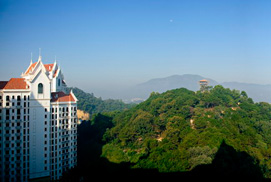洞察现实
建筑有两个重要的关系,第一是建筑与环境的关系,第二是建筑与人的关系。
建筑最基本的功能是定义空间。建筑结构划分了室内外空间,但也成为联系人与环境的重要手段。许多休闲度假酒店,拥有良好的自然环境以及与环境紧密相连的设计,这正是人们所渴求的。尤其在度假酒店的设计中,建筑师更应扮演的角色是有效沟通客人与环境的关系。为了更有效地发挥功能,建筑必须营造归宿感,一个感性的地方。如果缺少这种自然生长的感觉,建筑与环境将会是格格不入的,客人会有被蒙骗的感觉。
建筑必须传达值得信赖的与环境和谐统一的感觉。度假酒店通常位于自然环境中,因此建筑本身不能凌驾于环境,应该扮演一个相对环境来说次要的角色,甚至应该保护和提升自然环境的优势。建筑应该根据地势的条件顺应自然地去设计。为了保持一种和谐的状态,建筑物应该尽可能地适应地理位置和环境的要求。建造过程中就地取材将给客人造成一种真实、归宿的感觉。通过本地材料的使用,建筑物成一种自然的延伸,它看起来更像从自然中生长出来的而不是人造的。天然的选材使建筑仿佛有了历史的痕迹,有了属于它们自身的生活故事,它们就像是经历了漫长的历史并最终成为人类居所的一部分。
建筑设计必须反映适应当地环境条件的所有因素,例如冷暖的变化、潮湿度和雨水量等等。它必须建立在对项目所在地充分了解的基础上。建筑也必须在体量和装饰物、在结构和细节上传达一种真实的文化。人类的进化和社会的进步也是他们对生活的环境的一种自然的反映。一种当地建筑风格是经过漫长的历史,在不断对自然环境做出反映下演化而来的,它的设计和细节告诉我们几个世纪以来当地人与他们所处环境相互间的一个个真实的故事。它通过人的视角反映一个地区的文化和历史。建筑师必须创造一种建筑物能够传达丰富的历史和文化的变迁,不仅仅从细节上,而且更应该从精神层面上。
Perception is Reality
Architecture has two primary and equally important relationships, its association with its environment, and its association with the people it serves. The most basic function of architecture is to define space. Structures separate the interior from the exterior. They are an avenue of communication between the indoor and the outdoor, and by extension they are a connection between people and places. For many resort destinations, the natural environment and the desire to commune with nature is the experience that guests seek. Particularly at these resorts, the architecture must act as an effective conduit between the guests and their surroundings. In order to function effectively, it must convey a feeling of belonging, a sense of place. Without this “grounding in locality”, the architecture will be in a state of conflict with its surroundings, and this deception will be sensed by the guests. In order to be believed, the architecture must convey a feeling of oneness with the site. For a destination resort situated in a natural setting, the architecture must not overpower the environment. It should play a subordinate role to the site, acting to preserve and enhance the natural site features. The buildings should be designed to conform to the existing site conditions and topography. In order to maintain a state of harmony, buildings should accommodate the requirements of the site and work within its constraints. The use of natural, local materials instills a sense of authenticity and honesty in the construction. Through their use, the building takes on the appearance of a natural extension of the site. It looks less man-made and more as an outgrowth of nature. The natural materials convey a history of their own existence, a story of their life and eventual incorporation into human use and the construction of the building. To be believed, the architectural design must be responsive to all aspects of local environmental conditions, such as variations in heat, humidity, and rainfall. It must convey a sense of understanding of the place that it occupies. The architecture must also express a cultural honesty in form and adornment, in structure and detail. The evolution of a people and a society are also a natural reaction to the environments they occupy. A local architectural style evolved through history as a response to its environment. Its design and detailing tells a story of man's relationship to his particular environment over the centuries. It embodies the culture and history of a region from a human perspective. The architect must create buildings that convey, and pay homage to, this rich history and cultural evolution, not only in detail, but also in spirit.
  |
